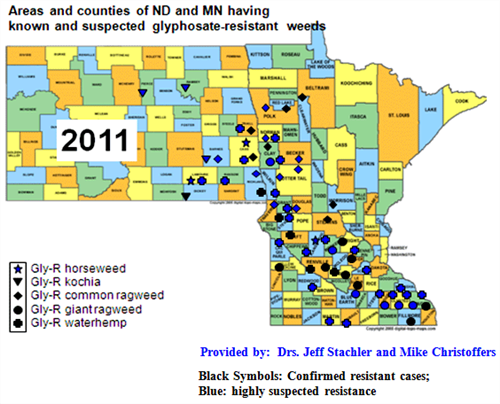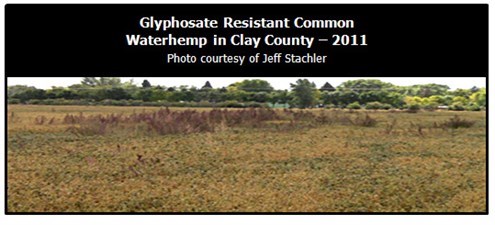561 - Herbicide Resistant Weed Development and Management
Weed resistance to herbicides has been occurring for several decades in North Dakota and Minnesota. Resistance may develop with repeated use of a specific herbicide for several years or use of multiple herbicides from the same mode-of-action group throughout the crop rotation. Weed characteristics that increase the likelihood of resistance development include large plant numbers, prolific seed production, high rates of weed spread (flooding in the RRV), presence and growth in diverse environmental conditions. Eight or more weed species have developed resistance to six different modes of action of herbicides in northeast North Dakota and northwest Minnesota at this time. Resistant weed development has been caused primarily by very irresponsible weed management practices.
Glyphosate Resistant Weeds in Minnesota and North Dakota
Glyphosate resistant weeds have developed in all three sugarbeet growing areas of Minnesota and North Dakota in the last few years. See Figure below.

Glyphosate resistant weeds in Minnesota and North Dakota sugarbeet producing counties are 1) horseweed 2) kochia 3) common ragweed 4) giant ragweed and 5) waterhemp. Lambsquarters resistance is suspected and being analyzed for at this time.
Weeds expressing some natural tolerance to glyphosate include 1) Cinquefoil 2) clover 3) lambsquarters 4) common mallow 5) dandelion 6) horseweed 7) kochia 8) nightshade 9) nutsedge 10) prickly lettuce 11) smartweed 12) velvetleaf 13) waterhemp and 14) wild buckwheat
Strategies to Minimize Herbicide Resistant Weed Development
- Scout fields regularly to identify weeds that escape herbicide treatment
- Apply herbicides in tank-mixes, or sequential mixtures that include multiple modes of action
- Rotate herbicides with different modes of action in consecutive years
- Rotate crops to enable utilization of different modes of action
- Use labor and mechanical weed control as necessary
Management Strategies after Resistant Weeds Develop
- Change to alternative herbicide modes of action for the weed problem in question
- Use mechanical weed control options
- Use hand labor if only a few resistant weeds are present
- Change mix of crops in rotation to utilize new herbicide modes of action. Use of Liberty Link soybeans for example:
- ACT NOW - don't increase risk of losing the best herbicide (glyphosate) ever developed

Learn More - Don't miss the 2012 NDSU/UM beet grower seminar presentation by Dr. Jeff Stachler, NDSU/UM Extension Sugarbeet Weed Control Specialist "Discussing resistant weed issues past, present, future."
